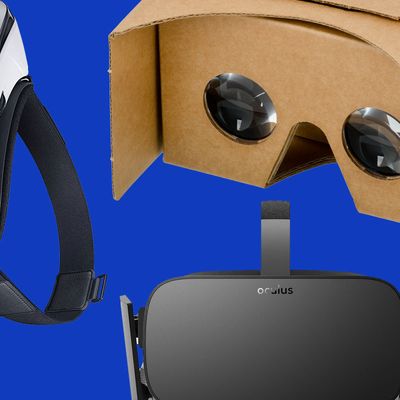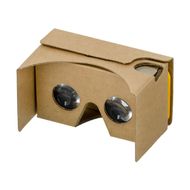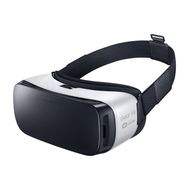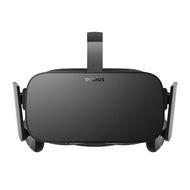
Reality hasn’t been making a great case for itself lately. Fortunately, virtual reality has gotten good enough to provide a decent escape hatch.
The best thing about the virtual-reality wave that’s currently cresting? It encompasses a whole range of devices, from cheap, phone-based players to elaborate rigs that cost as much as a used Toyota Celica. Options are great, but can also be confounding. Let us unconfound you.
The Basics: Google Cardboard

The best thing about Google Cardboard is that it requires almost no investment, aside from about $20 bucks and a willingness to hold a box up to your face for an extended period of time. In fact, if you were a New York Times print subscriber last fall, you already have one; in a moment of nerd delirium, the Grey Lady bundled a free Cardboard player with a Sunday paper last November.
Importantly, Cardboard isn’t any one specific device. It’s more of a virtual-reality platform. Lots of companies make Cardboard viewers; there’s even a View-Master version for the ‘80s kids. (The one we’ve linked to above is the buy-it-from-Google version, which is generally the cheapest.) You can even make one at home (Google provides instructions) although I wouldn’t recommend it, because if you’re someone looking for a fun digital diversion, you’re probably not also someone who wants to track down a neodymium ring magnet and two biconvex lenses, or even honestly carve out space in your brain to understand what those are.
Once you have your exceptionally cheap hardware in hand, using Cardboard is dead simple; just open the Cardboard app on your iPhone or Android phone, plop said phone into the viewer, and enjoy any of the “thousands” of virtual-reality apps and games and YouTube videos available.
Those scare quotes aren’t meant as a knock, really. But it’s worth noting that a lot of what Cardboard offers isn’t technically virtual reality; it’s “360° video.” These are still cool! The difference is that using Cardboard is often a passive experience. When you watch the cast of The Lion King in Cardboard you can look around but you can’t move around, at least not independent of wherever the camera’s positioned.
There are still plenty of fun experiences, though. You can ride roller coasters and in Volvos, or settle in for a 360-degree “true horror experience” called Sisters. One of the best Cardboard content creators, not surprisingly, is the New York Times, which has invested heavily in releasing compelling mini-documentaries in 360-degree glory every few months.
Once you’re done, you should have a better idea if you’re ready for a more potent virtual-reality system. Just know that it’s going to cost you. A lot.
The Step-Up: Samsung Gear VR

The difference between a Cardboard and Gear VR is like the difference between a McDonald’s Quarter Pounder and a P.J. Clarke’s bacon cheeseburger. They’re basically the same, except in all the ways that really matter.
The Gear VR is also a straightforward viewer that relies on your phone, except this one comes with straps, for a hands-free experience. No risk of elbow cramps here, and you come out about even in terms of looking like a doofus.
What really elevates the Gear VR, though, is that it has built-in sensors that track the movement of your head, which means the virtual environment will respond to some of your cranial twists and turns. (Importantly, it doesn’t know whether you’re leaning in or out; that technological trickery is reserved for the high-end stuff). It also comes with controls on the side, but if you plan to play a lot of games you can always use a Bluetooth controller.
And you should plan to play games! If not, maybe don’t bother, since the other experiences — you can watch 2-D Netflix in a virtual cabin? I guess? — aren’t really worth it. Start with Land’s End, from the people who made the addictive, Escheresque Monument Valley smartphone app. If you just want to shoot stuff real good, try EVE: Gunjack.
That is, if you’re eligible to try the Gear VR at all. In Samsung’s ongoing quest to keep people within its world of devices the way Apple does (the green-eyed monster which doth lock in!), Gear VR only works with recent, high-end Samsung Galaxy smartphones. If you already have one of those —and, hey, why not, they’re good phones — then a Gear VR should be a no-brainer. The same goes for PlayStation VR, announced last year but not available until this fall, and which will only be compatible with the PS4 and whatever updated console Sony announces at E3 next month.
If you don’t have either that specific phone or console already, it’s probably not worth spending hundreds of dollars on a new one just so you can spend another $100 (or more, in the case of PS VR) on a goofy VR headset to match.
Besides, if you were tempted to spend that much on virtual reality, you might as well go all-out.
The Big Leagues: Oculus Rift

It may feel like the Oculus Rift has been around for ages, and in some form it has; it first launched as a Kickstarter campaign back in 2012. Four years (and an acquisition by Facebook) later, an actual product is finally on sale. And it’ll cost you.
The Oculus Rift costs $600 on its own, and that’s before you get into the computer power you’ll need to run it. It’s only compatible with not just PCs, but PCs that cost at least a grand. Which means that, all in, you’re looking at $1,600 before tax.
If you’re still undeterred, here’s what that gets you: a standalone headset (no phone required) that delivers an experience that comes very close to making you forget where you are. Short films, games, a simulation of floating in space; all of these already exist for Rift in just the first few months of its existence. Plenty more is on the way.
Most of all, the Rift is exponentially more immersive than anything else on this list. The virtual environment responds when you lean in or out, or turn. The perspective shifts as though these things are actually in front of you. That might not sound like a lot, but to revisit an earlier analogy, it’s the difference between a burger and a prime steak.
Oculus Rift isn’t the only high-end virtual-reality system; the HTC Vive looks mighty impressive as well. The Vive demands a more complicated set-up, though, is more expensive, and involves walking around your room instead of standing mostly still, which might be more immersive, but will also result in more bruised shins.
Here’s the catch, though! In a few years, Oculus Rift and HTC Vive will both look like the original Atari by the time Xbox came out. These aren’t just brand-new products, they’re a brand-new product category. That means there’s not much you can do with them yet, and the experiences are fun but unrefined. Unless you’re among the earliest of adopters, you’ll save yourself so much money and probably a few literal headaches by waiting a year or two before you invest heavily in VR.
And until then? There’s always Cardboard.





























